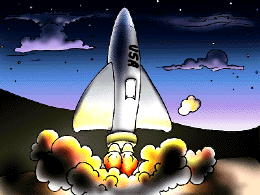


In preparation for extended missions in space, scientists are developing simulations of enclosed space stations. These enclosed spaces are called Closed Ecological Life Support Systems, or CELSS for short.
The largest CELSS project yet is Biosphere II in the Sonoran desert of Arizona. Biosphere II contains three acres sealed from our atmosphere under glass. Biosphere II contains eight different biomes including desert, salt marsh, ocean, rain forest, tropical savanna, rain forest, agricultural area, and human habitat. Each of these environments has its own rich communities of microbes.
In 1991, 8 people were sealed inside Biosphere II for 2 years. Microbes helped maintain life in Biosphere II for all that time. Microbes recycled wastes, purified the air, and changed the atmosphere.
![]() Microbes Used to Purify Air:
Microbes Used to Purify Air:
Biosphere II has 30,000 tons of soil containing billions and billions of microbes. The microbes recycle dead plants in the soil and some of these microbes eat pollutants in the air keeping the air safe to breathe.
![]() Microbes Deplete Oxygen in Biosphere II:
Microbes Deplete Oxygen in Biosphere II:
Microbes profoundly affected Biosphere II, as they do Biosphere I (the Earth). In Biosphere II, microbes where found to be responsible for the decreasing levels of oxygen, which dropped from 20 percent to less than 14 percent. Biosphere II had more microbes consuming oxygen than there were plants and photosynthetic, oxygen producing (oxygenic) bacteria that could recycle oxygen through photosynthesis.
Build your own miniature biosphere. To do this, all you need is a jar and lid and some pond water. Put pond water in the jar and seal this with the lid. Watch what happens to the biosphere over time. Can you see that the biosphere is changing?
![]()
The Russians have had Space Station Mir in space. The United States has plans for building Space Station Freedom. In the future, both of these stations may use microbes to help create a permanent stations. Microbes would recycle water and could be used for food production.
![]()
If humans are to build a station on the Moon, microbes may help make the station permanent. Using technology developed from CELSS research such as that done in Biosphere II, scientists can use microbes to create a self sustaining ecology on the moon.
Although most microbes will be beneficial in space missions, some microbes have shown to be problems in space. These grow on surfaces and instruments and they corrode metals. More research is needed to figure out how to control these microbes.